The use of Business Intelligence in Predicting Market Trends
Added on 2020-10-22
43 Pages14107 Words90 Views
The use of Business
Intelligence (Advance/
Predictive Analytics) in
Predicting Market Trends
Intelligence (Advance/
Predictive Analytics) in
Predicting Market Trends
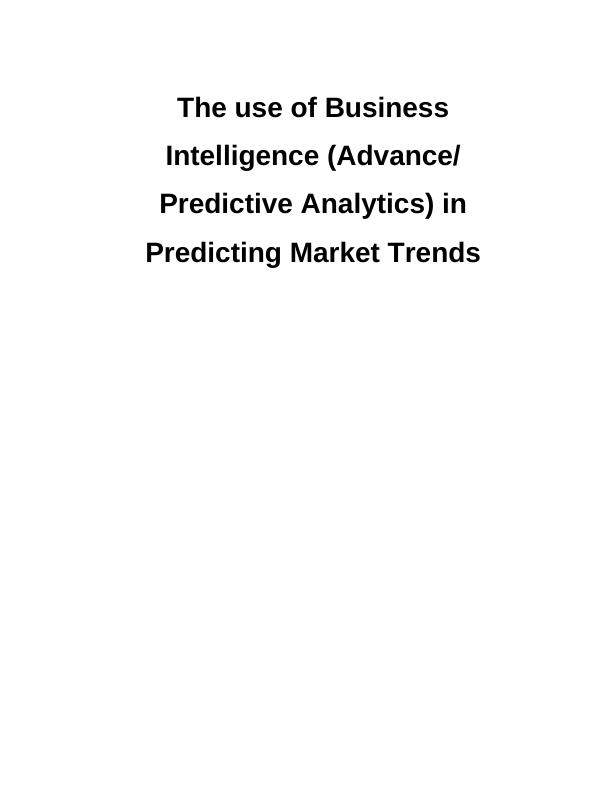
TABLE OF CONTENTS
RESEARCH TOPIC..................................................................................................................... 1
CHAPTER 1: INTRODUCTION...................................................................................................1
Overview of the study......................................................................................................... 1
Background of company.....................................................................................................2
Aim..................................................................................................................................... 2
Objectives........................................................................................................................... 2
Questions........................................................................................................................... 3
Rationale of study............................................................................................................... 3
Significance of study........................................................................................................... 3
Scope of Study................................................................................................................... 4
Structure of Dissertation.....................................................................................................4
CHAPTER 2: LITERATURE REVIEW..........................................................................................6
Use of business intelligence and advance & predictive analysis.........................................6
Market growth of fashion industry.....................................................................................10
Theories and models based on advance and predictive analytics....................................13
Recommendation of techniques for preventing the organisation from fraud, risk and financial
issues............................................................................................................................... 18
CHAPTER 3: RESEARCH METHODOLOGY............................................................................20
Research approach..........................................................................................................20
Research philosophy........................................................................................................21
Research type................................................................................................................... 22
Research design............................................................................................................... 22
Sampling........................................................................................................................... 22
Data collection.................................................................................................................. 23
Data Analysis.................................................................................................................... 23
Ethical Consideration........................................................................................................24
Reliability and viability.......................................................................................................24
CHAPTER 4: DATA ANALYSIS.................................................................................................25
CHAPTER 5: CONCLUSION AND RECOMMENDATION.........................................................34
Conclusion........................................................................................................................ 34
Recommendation..............................................................................................................36
REFERENCES.......................................................................................................................... 38
APPENDIX................................................................................................................................. 40
2
RESEARCH TOPIC..................................................................................................................... 1
CHAPTER 1: INTRODUCTION...................................................................................................1
Overview of the study......................................................................................................... 1
Background of company.....................................................................................................2
Aim..................................................................................................................................... 2
Objectives........................................................................................................................... 2
Questions........................................................................................................................... 3
Rationale of study............................................................................................................... 3
Significance of study........................................................................................................... 3
Scope of Study................................................................................................................... 4
Structure of Dissertation.....................................................................................................4
CHAPTER 2: LITERATURE REVIEW..........................................................................................6
Use of business intelligence and advance & predictive analysis.........................................6
Market growth of fashion industry.....................................................................................10
Theories and models based on advance and predictive analytics....................................13
Recommendation of techniques for preventing the organisation from fraud, risk and financial
issues............................................................................................................................... 18
CHAPTER 3: RESEARCH METHODOLOGY............................................................................20
Research approach..........................................................................................................20
Research philosophy........................................................................................................21
Research type................................................................................................................... 22
Research design............................................................................................................... 22
Sampling........................................................................................................................... 22
Data collection.................................................................................................................. 23
Data Analysis.................................................................................................................... 23
Ethical Consideration........................................................................................................24
Reliability and viability.......................................................................................................24
CHAPTER 4: DATA ANALYSIS.................................................................................................25
CHAPTER 5: CONCLUSION AND RECOMMENDATION.........................................................34
Conclusion........................................................................................................................ 34
Recommendation..............................................................................................................36
REFERENCES.......................................................................................................................... 38
APPENDIX................................................................................................................................. 40
2
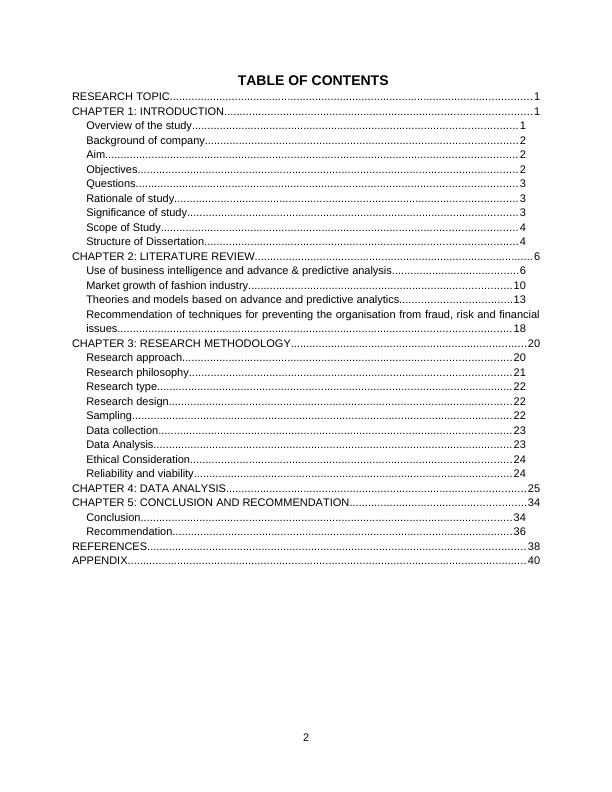
RESEARCH TOPIC
Use of business intelligence (advance/predictive analytics) in predicting market
trends: A case study on Marks and Spencer.
CHAPTER 1: INTRODUCTION
Overview of the study
Business intelligence is combination of advanced technologies and strategies
incorporate by business to improvise and enhance value of its services.
Implementation of analysis and technological tools promotes development, innovation
and profitable growth of an organization. Advanced and predictive analysis is effective
for company because it helps the firm in bridging a gap between threats and
opportunities which occurs due to changing business environment (Chau and Xu,
2012)1. The advanced tools and techniques of business intelligence helps the
enterprise in exploring wide information to manage successful business operations.
Implication of business intelligence is necessary because it promotes data analysis by
predicting market trends which helps in effective and systematic decision making for
forthcoming challenges. Further, it promotes problem solving approach by simplifying
data analysis with the help of advanced technological tools. Moreover, it is essential
because it promotes specific knowledge of industry which is the best way of managing
dynamic changes on time. Accumulation of specific information from industry is the
best way which assist the business in meeting customer expectation (Olszak and
Ziemba, 2012)2. Administration of business information via technological tools offers
systematic mode of storing information at secure location. With the help of safe
storage, the company is able to take back up of necessary data.
However, predictive and advanced analytic of market tends are effective for an
enterprise. It helps the company in managing cost effectiveness, data transparency,
sustainable growth and improved business performance which overall is productive
approach for the firm to manage inspiration and delivering exceptional quality goods to
shoppers. Business intelligence is based on various models and strategic approaches
like, artificial intelligence, business process re-engineering, robotics which encourages
flexible and systematic design for managing workflows and process of organizations.
1 Chau, M. and Xu, J., 2012. Business intelligence in blogs: Understanding consumer
interactions and communities. MIS quarterly. pp.1189-1216.
2 Olszak, C. M. and Ziemba, E., 2012. Critical success factors for implementing business intelligence
systems in small and medium enterprises on the example of upper Silesia, Poland. Interdisciplinary
Journal of Information, Knowledge and Management. 7. pp.129-151
1
Use of business intelligence (advance/predictive analytics) in predicting market
trends: A case study on Marks and Spencer.
CHAPTER 1: INTRODUCTION
Overview of the study
Business intelligence is combination of advanced technologies and strategies
incorporate by business to improvise and enhance value of its services.
Implementation of analysis and technological tools promotes development, innovation
and profitable growth of an organization. Advanced and predictive analysis is effective
for company because it helps the firm in bridging a gap between threats and
opportunities which occurs due to changing business environment (Chau and Xu,
2012)1. The advanced tools and techniques of business intelligence helps the
enterprise in exploring wide information to manage successful business operations.
Implication of business intelligence is necessary because it promotes data analysis by
predicting market trends which helps in effective and systematic decision making for
forthcoming challenges. Further, it promotes problem solving approach by simplifying
data analysis with the help of advanced technological tools. Moreover, it is essential
because it promotes specific knowledge of industry which is the best way of managing
dynamic changes on time. Accumulation of specific information from industry is the
best way which assist the business in meeting customer expectation (Olszak and
Ziemba, 2012)2. Administration of business information via technological tools offers
systematic mode of storing information at secure location. With the help of safe
storage, the company is able to take back up of necessary data.
However, predictive and advanced analytic of market tends are effective for an
enterprise. It helps the company in managing cost effectiveness, data transparency,
sustainable growth and improved business performance which overall is productive
approach for the firm to manage inspiration and delivering exceptional quality goods to
shoppers. Business intelligence is based on various models and strategic approaches
like, artificial intelligence, business process re-engineering, robotics which encourages
flexible and systematic design for managing workflows and process of organizations.
1 Chau, M. and Xu, J., 2012. Business intelligence in blogs: Understanding consumer
interactions and communities. MIS quarterly. pp.1189-1216.
2 Olszak, C. M. and Ziemba, E., 2012. Critical success factors for implementing business intelligence
systems in small and medium enterprises on the example of upper Silesia, Poland. Interdisciplinary
Journal of Information, Knowledge and Management. 7. pp.129-151
1
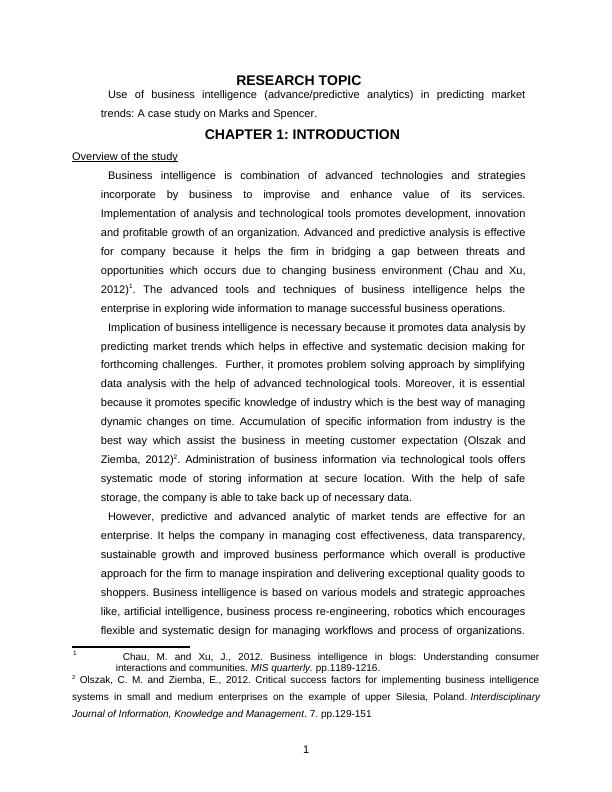
As per this, it can be argued that BI play vital role in envision of new process, initiating
change, diagnosing and redesigning of business process.
In accordance, it can be said that artificial intelligence is a critical part of business
intelligence which supports automation and according to different scholars AI offers the
best approach of managing market trend where in this the company process the
information and then aim at making continuous changes and alterations. The
application provides assessment of changing business trends on regular basis (Rubin
and Rubin, 2013)3. It is effective because it provides automated approach of learning
and improving which becomes easy for organization to deal with function of market.
Therefore, it can be said that technological approaches, strategies and tools of
business intelligence are effective for analysing changing trends of industry.
Background of company
Marks and Spencer is a British multinational retailer and is one of the listed London
stock exchange company. The company offers specialist clothing, home and luxury
products. The core values of organization are focused on inspiration, innovation, in
touch and integrity. The organization work with promise of enhancing lives every day
by managing regular communication with suppliers, employees and customers. The
marketing team of company conducts regular market research to analyses changing
buyer’s preferences and need of innovation in services. In accordance with changing
market trends of fashion industry it is important for the M&S to imply the use of
advanced strategies and technologies to manage sustainable business growth
(Popovič and et.al., 2012)4.
Aim
“The use of business intelligence (advance/predictive analytics) in predicting
market trends- a case study on Marks & Spencer”
Objectives
To identify the market growth in upcoming period for fashion industry.
To analyse the growth opportunity and industrial forecasts for favourable capital market
share.
To determine various theories and models based on advance and predictive analytics.
3 Rubin, E. and Rubin, A., 2013. The impact of business intelligence systems on stock return
volatility. Information & Management. 50(2-3). pp.67-75.
4 Popovič, A. and et.al., 2012. Towards business intelligence systems success: Effects of
maturity and culture on analytical decision making. Decision Support Systems. 54(1). pp.729-
739.
2
change, diagnosing and redesigning of business process.
In accordance, it can be said that artificial intelligence is a critical part of business
intelligence which supports automation and according to different scholars AI offers the
best approach of managing market trend where in this the company process the
information and then aim at making continuous changes and alterations. The
application provides assessment of changing business trends on regular basis (Rubin
and Rubin, 2013)3. It is effective because it provides automated approach of learning
and improving which becomes easy for organization to deal with function of market.
Therefore, it can be said that technological approaches, strategies and tools of
business intelligence are effective for analysing changing trends of industry.
Background of company
Marks and Spencer is a British multinational retailer and is one of the listed London
stock exchange company. The company offers specialist clothing, home and luxury
products. The core values of organization are focused on inspiration, innovation, in
touch and integrity. The organization work with promise of enhancing lives every day
by managing regular communication with suppliers, employees and customers. The
marketing team of company conducts regular market research to analyses changing
buyer’s preferences and need of innovation in services. In accordance with changing
market trends of fashion industry it is important for the M&S to imply the use of
advanced strategies and technologies to manage sustainable business growth
(Popovič and et.al., 2012)4.
Aim
“The use of business intelligence (advance/predictive analytics) in predicting
market trends- a case study on Marks & Spencer”
Objectives
To identify the market growth in upcoming period for fashion industry.
To analyse the growth opportunity and industrial forecasts for favourable capital market
share.
To determine various theories and models based on advance and predictive analytics.
3 Rubin, E. and Rubin, A., 2013. The impact of business intelligence systems on stock return
volatility. Information & Management. 50(2-3). pp.67-75.
4 Popovič, A. and et.al., 2012. Towards business intelligence systems success: Effects of
maturity and culture on analytical decision making. Decision Support Systems. 54(1). pp.729-
739.
2

To suggest appropriate techniques for preventing the organisation from fraud, risk and
financial issues.
Questions
How to identify the market growth in upcoming period for fashion industry?
What are the growth opportunity and industrial forecasts for favourable capital market
share?
How to determining various theories and models based on advance and predictive
analytics?
What are the suggestions for appropriate techniques for preventing the organisation
from fraud, risk and financial issues?
Rationale of study
The motive of conducting this research is to explore the idea of business intelligence
and use of advanced and predictive analytic for predicting fashion trends. The study
will help in outlining various models and theories which are part of business intelligence
are can be effectively used by multinational retailer in making innovation in services
according to changing shoppers needs and preferences. BI is driven by technology and
therefore is effective for decision making by collaborating information shared by
executives, manager, employees and customers. However, the research is conducted
for academic purpose and learning and will help the scholar in evaluating need of
implying BI in an organization.
Significance of study
The significance of research is outlined in background from where it is determined
that BI offers systemic collaboration and analysis of information which helps the
business in managing forthcoming challenges. The research is important to design
strategic planning process which can assist the retailer in predicting fashion trends.
Further, it will assist the firm in coordinating key functions of organization that is
gathering, storing, access and analyzing corporate data. The research topic is
significant as it will promote self-development of scholar by boosting individual learning
over advanced technological tools and its benefits. Moreover, the study is meaningful
and important because it will help in determining about advanced and predictive
analysis which play a crucial role in making estimate and deriving accurate results.
Scope of Study
The scope of study is wide because Business intelligence is a wide topic and
research will be based on exploring its different aspects like, technological tools,
3
financial issues.
Questions
How to identify the market growth in upcoming period for fashion industry?
What are the growth opportunity and industrial forecasts for favourable capital market
share?
How to determining various theories and models based on advance and predictive
analytics?
What are the suggestions for appropriate techniques for preventing the organisation
from fraud, risk and financial issues?
Rationale of study
The motive of conducting this research is to explore the idea of business intelligence
and use of advanced and predictive analytic for predicting fashion trends. The study
will help in outlining various models and theories which are part of business intelligence
are can be effectively used by multinational retailer in making innovation in services
according to changing shoppers needs and preferences. BI is driven by technology and
therefore is effective for decision making by collaborating information shared by
executives, manager, employees and customers. However, the research is conducted
for academic purpose and learning and will help the scholar in evaluating need of
implying BI in an organization.
Significance of study
The significance of research is outlined in background from where it is determined
that BI offers systemic collaboration and analysis of information which helps the
business in managing forthcoming challenges. The research is important to design
strategic planning process which can assist the retailer in predicting fashion trends.
Further, it will assist the firm in coordinating key functions of organization that is
gathering, storing, access and analyzing corporate data. The research topic is
significant as it will promote self-development of scholar by boosting individual learning
over advanced technological tools and its benefits. Moreover, the study is meaningful
and important because it will help in determining about advanced and predictive
analysis which play a crucial role in making estimate and deriving accurate results.
Scope of Study
The scope of study is wide because Business intelligence is a wide topic and
research will be based on exploring its different aspects like, technological tools,
3
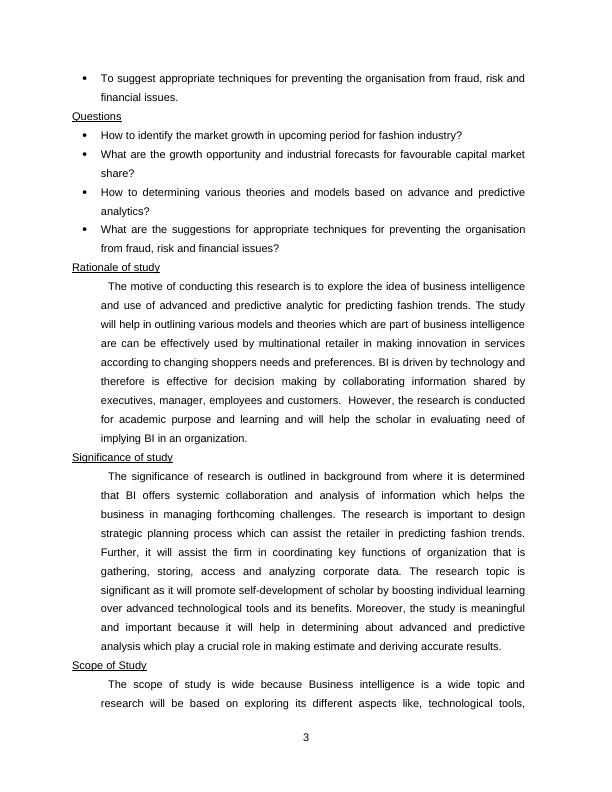
strategical planning, implication in retail firm, predictive and advanced analysis, etc.
The study will help in determining sustainable growth, increased efficiency, strategic
control, data transparency and risk minimization (Business intelligence (BI), 2018)5. It is
based on primary and secondary both data collection method with the help of which
researcher will be able to explore facts of topic with regard to present technological
changes. Further, it will help in outlining decrease in cost, cost effectiveness, optimum
utilization of resources, quality management and improve business performance of
Marks and Spencer by keeping a check of changing fashion trends.
Structure of Dissertation
Introduction Chapter 1: This is introductory phase of study where researcher focus
on developing understanding over chosen research topic and organisation. This helps
in analysing needs of managing particular changes in business enterprise. Further, the
chapter comprise scope of study which helps in predicting topic which will be discussed
and covered to address aim and research questions. Further, rational of research is
derived to analyse motive of choosing particular topic.
Literature review Chapter 2: It is an accumulation of secondary sources where the
researcher will outline themes which are based on research objectives. Further,
research will be done on the basis of key themes to address particular topic. It is
collection of information from Books, journals, articles, magazines, blogs, etc. This
chapter of study is effective for boosting learning over all the aspects and ideas of
study. Like the chapter 2 will comprise fashion trends, advanced and predictive
analytic, approaches and technological tools of business intelligence, recommendation
and strategic planning process which can be implied by Marks and Spencer to predict
fashion trends.
Research methodology Chapter 3: This chapter of study is implication of
methodological tools which helps in managing set of process of collecting and
analysing information. In this researcher derives use of research design, philosophy
and approach which helps in analysing human interest and perception of chosen topic.
Further, it demonstrates understanding over sampling of population who will be helping
researcher in gathering valid and reliable information. Further, in this phase the
researcher will predict information collection methods that is primary and secondary
5 Business intelligence (BI). 2018. [Online] Available through:
<https://searchbusinessanalytics.techtarget.com/definition/business-intelligence-BI>.
4
The study will help in determining sustainable growth, increased efficiency, strategic
control, data transparency and risk minimization (Business intelligence (BI), 2018)5. It is
based on primary and secondary both data collection method with the help of which
researcher will be able to explore facts of topic with regard to present technological
changes. Further, it will help in outlining decrease in cost, cost effectiveness, optimum
utilization of resources, quality management and improve business performance of
Marks and Spencer by keeping a check of changing fashion trends.
Structure of Dissertation
Introduction Chapter 1: This is introductory phase of study where researcher focus
on developing understanding over chosen research topic and organisation. This helps
in analysing needs of managing particular changes in business enterprise. Further, the
chapter comprise scope of study which helps in predicting topic which will be discussed
and covered to address aim and research questions. Further, rational of research is
derived to analyse motive of choosing particular topic.
Literature review Chapter 2: It is an accumulation of secondary sources where the
researcher will outline themes which are based on research objectives. Further,
research will be done on the basis of key themes to address particular topic. It is
collection of information from Books, journals, articles, magazines, blogs, etc. This
chapter of study is effective for boosting learning over all the aspects and ideas of
study. Like the chapter 2 will comprise fashion trends, advanced and predictive
analytic, approaches and technological tools of business intelligence, recommendation
and strategic planning process which can be implied by Marks and Spencer to predict
fashion trends.
Research methodology Chapter 3: This chapter of study is implication of
methodological tools which helps in managing set of process of collecting and
analysing information. In this researcher derives use of research design, philosophy
and approach which helps in analysing human interest and perception of chosen topic.
Further, it demonstrates understanding over sampling of population who will be helping
researcher in gathering valid and reliable information. Further, in this phase the
researcher will predict information collection methods that is primary and secondary
5 Business intelligence (BI). 2018. [Online] Available through:
<https://searchbusinessanalytics.techtarget.com/definition/business-intelligence-BI>.
4
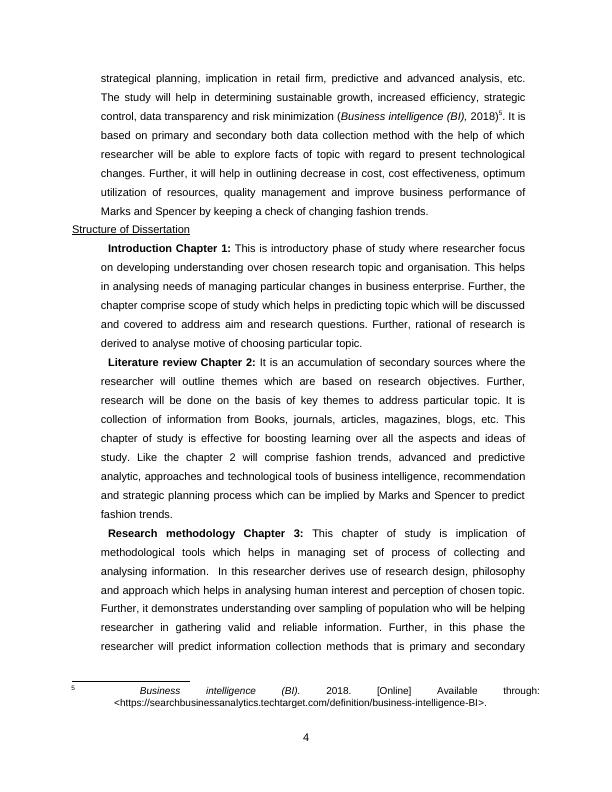
where ethics are implied by scholar to managing confidentiality and reliability of
gathered data.
Data analysis Chapter 4: In this chapter research analyses collected information
which encourages discussion is done with motive of developing understanding provide
significance of research topic. This based on graphical presentation and thematic
analysis which helps in making segregation in research aspects like business
intelligence, its implication in M&S, different tools of BI, advantages of implementing BI.
This chapter promotes clear understanding over aim by deriving outcomes in form of
findings and discussion.
Conclusion and recommendation Chapter 5: This is the last chapter of study in
which scholar summarizes over all findings and discussion. In this focus of scholar will
be on making step wise conclusion as it demonstrates clear understanding over each
chapter. It is outline of results on the basis of which recommendation are made which
will help the researcher in determining gap of study and topic. Suggestion of study will
be given by scholar on the basis of overall analysis and in comparison with
organizational approach for managing fashion trends.
5
gathered data.
Data analysis Chapter 4: In this chapter research analyses collected information
which encourages discussion is done with motive of developing understanding provide
significance of research topic. This based on graphical presentation and thematic
analysis which helps in making segregation in research aspects like business
intelligence, its implication in M&S, different tools of BI, advantages of implementing BI.
This chapter promotes clear understanding over aim by deriving outcomes in form of
findings and discussion.
Conclusion and recommendation Chapter 5: This is the last chapter of study in
which scholar summarizes over all findings and discussion. In this focus of scholar will
be on making step wise conclusion as it demonstrates clear understanding over each
chapter. It is outline of results on the basis of which recommendation are made which
will help the researcher in determining gap of study and topic. Suggestion of study will
be given by scholar on the basis of overall analysis and in comparison with
organizational approach for managing fashion trends.
5
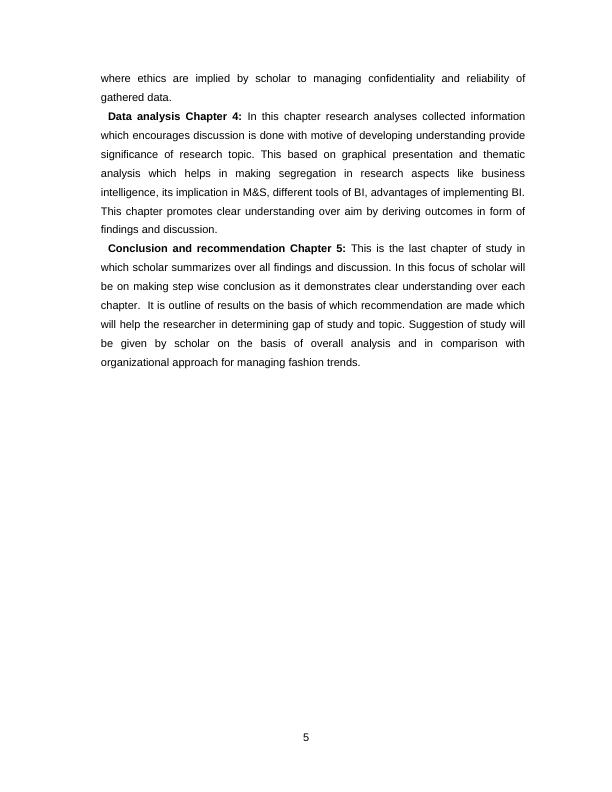
CHAPTER 2: LITERATURE REVIEW
This chapter is review of different secondary sources which helps in developing
critical understanding over research topic. The chapter is based on objective of
research which helps in outlining every source of the information to address aim. In
this, scholar seeks different book, articles, journals, governmental publication,
magazines to find relevant information to gain insight of topic.
Use of business intelligence and advance & predictive analysis
According to Chen, Chiang and Storey, (2012)6, business intelligence offers set of
strategic tools and techniques which helps the organization in transforming information
in meaningful way of managing cost effectiveness and for improving performance of
organization. It is the approach of managing application, strategic planning, information
analysis and prediction to generating better outcomes. IT is based on key skills in
enterprise that is problem solving, data analysis, communication and relevant
knowledge about industrial trends. Implication of BI is becoming essential for the
companies across the globe because it offers quick reporting, effective decision
making, improved quality of data, improved efficiency of operations, customer
satisfaction, quality management and increased competitive advantage. As per the
view of Popovič and et.al., (2012)7, business intelligence offers strategical tool to
analyzing changing business trends which is the most efficiency way of managing cost
effectiveness and meeting customer expectations. The company supports the use of BI
because it promotes critical thinking where the firm is able to manage innovation,
transparency in information management and systematic documentation.
Thamir and Poulis, (2015)8, discussed about different advancement which supports BI
that is robotics, artificial intelligence and business process re-engineering. These are
common automation which have boosted the world of business by making predicting
simpler and management systematic. It enables justified and flexible planning in case
of changing industrial trends which is basis of managing innovation and meeting
customer expectation. Regular check over changing customer preferences play crucial
6 Chen, H., Chiang, R. H. and Storey, V. C., 2012. Business intelligence and analytics: from big
data to big impact. MIS quarterly. pp.1165-1188.
7 Popovič, A. and et.al., 2012. Towards business intelligence systems success: Effects of
maturity and culture on analytical decision making. Decision Support Systems. 54(1). pp.729-
739.
8 Thamir, A. and Poulis, E., 2015. Business intelligence capabilities and implementation
strategies. International Journal of Global Business. 8(1). p.34.
6
This chapter is review of different secondary sources which helps in developing
critical understanding over research topic. The chapter is based on objective of
research which helps in outlining every source of the information to address aim. In
this, scholar seeks different book, articles, journals, governmental publication,
magazines to find relevant information to gain insight of topic.
Use of business intelligence and advance & predictive analysis
According to Chen, Chiang and Storey, (2012)6, business intelligence offers set of
strategic tools and techniques which helps the organization in transforming information
in meaningful way of managing cost effectiveness and for improving performance of
organization. It is the approach of managing application, strategic planning, information
analysis and prediction to generating better outcomes. IT is based on key skills in
enterprise that is problem solving, data analysis, communication and relevant
knowledge about industrial trends. Implication of BI is becoming essential for the
companies across the globe because it offers quick reporting, effective decision
making, improved quality of data, improved efficiency of operations, customer
satisfaction, quality management and increased competitive advantage. As per the
view of Popovič and et.al., (2012)7, business intelligence offers strategical tool to
analyzing changing business trends which is the most efficiency way of managing cost
effectiveness and meeting customer expectations. The company supports the use of BI
because it promotes critical thinking where the firm is able to manage innovation,
transparency in information management and systematic documentation.
Thamir and Poulis, (2015)8, discussed about different advancement which supports BI
that is robotics, artificial intelligence and business process re-engineering. These are
common automation which have boosted the world of business by making predicting
simpler and management systematic. It enables justified and flexible planning in case
of changing industrial trends which is basis of managing innovation and meeting
customer expectation. Regular check over changing customer preferences play crucial
6 Chen, H., Chiang, R. H. and Storey, V. C., 2012. Business intelligence and analytics: from big
data to big impact. MIS quarterly. pp.1165-1188.
7 Popovič, A. and et.al., 2012. Towards business intelligence systems success: Effects of
maturity and culture on analytical decision making. Decision Support Systems. 54(1). pp.729-
739.
8 Thamir, A. and Poulis, E., 2015. Business intelligence capabilities and implementation
strategies. International Journal of Global Business. 8(1). p.34.
6

End of preview
Want to access all the pages? Upload your documents or become a member.
Related Documents
Impact of Artificial Intelligence on Organizational Decision makinglg...
|27
|5677
|25
Data Analysis Research Paper 2022lg...
|38
|11003
|26
Data Handling and Business Intelligencelg...
|8
|1460
|313
Dissertation on Information Technology: Exploring Opportunities and Challenges of Artificial Intelligence in the Finance Industrylg...
|73
|18507
|194
AI in Startup Digital Companieslg...
|63
|16996
|63
Data Handling and Business Intelligencelg...
|8
|1740
|93
